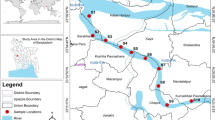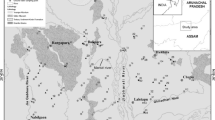Abstract
An increasing trend in water pollution of freshwater bodies through anthropogenic means is evident, and its impact is turning freshwater unsuitable for human consumption. In addition to physicochemical nature of such water, presence of the type of vegetation has been significant in labeling such bodies for different levels of pollution. Physicochemical parameters include important criteria like temperature, free carbon dioxide (CO2), turbidity, total alkalinity, electrical conductivity, nitrate etc., which provide an idea for the portability of water for irrigation and drinking purposes. In this investigation, eight water bodies (76∘46′45.96″ E, 30∘44′01.19″ N) have been studied and categorized into different water quality indices as per permissible limits of WHO, ICMR, and ISI standards. The values of water quality index (WQI) at water bodies (ponds) S1–S8 were 46.12, 56.90, 79.96, 103.31, 120.39, 14.53, 29.47, and 30.58 respectively, which clearly indicated anthropogenic activities to different levels. The water bodies S1–S5 could be categorized as “D–E”, and water at S6–S8 as “A–B” as per Central Pollution Control Board (CPCB) guidelines. Principal component analysis (PCA) has been applied to classify the water bodies into four different categories which produced the same results as WQI. Agglomerative cluster analysis (CA) was performed for delineating and grouping the similar pollution causing areas. The parameters like free CO2, turbidity, total alkalinity, electrical conductivity and TDS were higher in Eichhornia crassipes infested water bodies than the one supporting growth of a stonewort (Chara corallina). Management strategies to save water from deterioration should be focused accordingly, keeping in view this information gathered.



Similar content being viewed by others
References
Akasaka M, Takamura N, Mitsuhashi H, Kadono Y (2010) Effects of land use on aquatic macrophyte diversity and water quality of ponds. Freshw Biol 55:909–922
APHA, AWWA, WEF (2005) Standard methods for the examination of water and waste water (21st ed.). New York, Washington, DC. Jointly prepared and published by American Public Health Association, American Water Works Association and Water Environment Federation
Arora J, Mehra NK (2009) Seasonal dynamics of zooplankton in a shallow eutrophic, man-made hyposaline lake in Delhi (India): role of environmental factors. Hydrobiologia 626:27–40
Barker T, Hatton K, O’Connor M, Connor L, Bagnell L, Moss B (2008) Control of ecosystem state in a shallow, brackish lake: implications for the conservation of stonewort communities. Aquat Conserv 18:221–240
Bellinger EG, Sigee DC (2010) Freshwater algae: identification and use as bioindicators. Wiley/Blackwell, London
Carpenter SR, Lodge DM (1986) Effects of submersed macrophytes on ecosystem processes. Aquat Bot 26:341–370
Dale HM, Gillespie TJ (1976) The influence of floating vascular plants on the diurnal fluctuations of temperature near the water surface in early spring. Hydrobiologia 49:245–256
Das SK, Biswas D, Roy S (2009) Study of hydrophytes in some lentic water bodies in West Bengala, India. Ecoprint 16:9–13
del Pozo R, Alaez CF, Alaez MF (2010) An assessment of macrophyte community metrics in the determination of the ecological condition and total phosphorus concentration of Mediterranean ponds. Aquat Bot 92:55–62
Dhote S, Dixit S (2009) Water quality improvement through macrophytes—a review. Environ Monit Assess 152:149–153
Dierberg FE, DeBusk TA, Jackson SD, Chimney MJ, Pietro K (2002) Submerged aquatic vegetation-based treatment wetlands for removing phosphorus from agricultural runoff: response to hydraulic and nutrient loading. Water Res 36:1409–1422
Ferrat L, Martini CP, Romeo M (2003) Assessment of the use of biomarkers in aquatic plants for the evaluation of environmental quality: application to seagrass. Aquat Toxicol 65:187–204
Flint NA, Madsen JD (1995) The effect of temperature and day length on the germination of Potamogeton nodosus tubers. J Freshw Ecol 10:125–128
Frodge JD, Marino DA, Pauley GB, Thomas GL (1995) Mortality of large month bass (Micropterus salmoides) and steelhead trout (Oncorhynchus mykiss) in densely vegetated littoral areas tested using in situ assay. Lake Reserv Manage 11:343–358
Harkins RD (1974) An objective water quality index. J Water Pollut Control Fed 46:589
Hasalam SM (1991) River pollution—an ecological perspective. Belhaven Press, Great Britain
ICMR (1975) Drinking water standards, Indian Council of Medical Research, New Delhi
ISI (1973) Indian standard methods for sampling and test (physical and chemical) for water used in industry. Indian Standard Institute, Manak Bhawan, New Delhi
Jindal R, Sharma C (2011) Studies on water of Sutlej River around Ludhiana with reference to physiochemical parameters. Environ Monit Assess 174:417–425
Kadlec RH (2000) The inadequacy of first-order removal models. Ecol Eng 15:105–119
Kesharwani S, Mandoli AK, Dube KK (2004) Determination of water quality index (WQI) of Amkhera Pond of Jabalpur city (M.P.). Nat J Life Sci 1(1):61–66
Khatiwada NR, Polprasert C (1999) Assessment of effective specific surface area for free water surface wetlands. Water Sci Technol 40:83–89
Kufel L, Kufel I (2002) Chara beds acting as nutrient sinks in shallow lakes: a review. Aquat Bot 72:249–260
Mahapatra SS, Sahu M, Patel RK, Panda BN (2012) Prediction of water quality using principal component analysis. Water Qual Expo Health 4(2):93–104
Mallory ML, Fontaine AJ, Smith PA, Robertson MOW, Gilchrist HG (2006) Water chemistry of ponds on Southampton Island, Nunavut, Canada: effect of habitat and ornithogenic inputs. Arch Hydrobiol 166(3):411–432
McVea C, Boyd CE (1975) Effect of water hyacinth cover on water chemistry, phytoplankton and fish in ponds. J Environ Qual 4:375–378
Mishra PC, Patel RK (2001) Study of pollution load in the drinking water of Rairangpur: a small tribal dominated town of North Orissa. Indian J Environ Ecoplan 5(2):293–298
Mohanta BK, Patra AK (2000) Studies on the water quality index of river Sanamachhakanandana at Keonjargarh, Orissa. Pollut Res 19(3):377–385
Mohapatra SP (1987) Heavy metal concentrations in industrial effluents changed to the Thana Creek. Indian J Environ Prot 7(4):284–286
Monjerezi M, Ngongondo C (2012) Quality of groundwater resources in Chikhwawa, Lower Shire Valley, Malawi. Water Qual Expo Health 4(1):39–53
Naik S, Purohit KM (2001) Studies on water quality of river Brahmani in Sundargarh district, Orissaf. Indian J Environ Ecoplan 5(2):397–402
Ogbogu SS (1991) The Bio-ecology of Cloeon and Caenis species (Ephemeroptera) in two man-made lakes in lakes Ibadan (p. 293). Dissertation, University of Ibadan
Ogunlade Y (1996) The chemistry of water hyacinth in Nigerian waterways. Government Printing Press, Akure Ondo State
Padmanabha B, Belagali SL (2008) Ostracods as indicators of pollution in the lake of Mysore. J Environ Biol 29(3):415–418
Pires JCM, Pereira MC, Alvim-Ferraz MCM, Martins FG (2009) Identification of redundant air quality measurements through the use of principal component analysis. Atmos Environ 43:3837–3842
Priya A, Avishek K, Pathak G (2012) Assessing the potentials of Lemna minor in the treatment of domestic wastewater at pilot scale. Environ Monit Assess 184(7):4301–4307
Rai DN, Munshi JD (1979) The influence of thick floating vegetation (Water hyacinth: Eichhornia crassippes) on the physicochemical environment of a freshwater wetland. Hydrobiologia 62:65–69
Rajagopal T, Thangamani A, Archunan G (2010a) Comparison of physico-chemical parameters and phytoplankton species diversity of two perennial ponds in Sattur area, Tamil Nadu. J Environ Biol 31(5):787–794
Rajagopal T, Thangamani A, Sevarkodiyone SP, Sekar M, Archunan G (2010b) Zooplankton diversity and physico-chemical conditions in three perennial ponds of Virudhunagar district, Tamil Nadu. J Environ Biol 31:265–272
Reddy KR, Sacco PD, Graetz DA, Campbell KL, Portier KM (1983) Effect of aquatic macrophytes on physicochemical parameters of agricultural drainage. J Aquat Plant Manage 21:1–7
Seema P (2012) Threats, management and envisaged utilization of aquatic weed Eichhornia crassipes: an overview. Rev Environ Sci Biotechnol 11:249–259
Servien EL, Clemenceau G, Gabory O, Douillard E, Haury J (2006) Stoneworts (Characeae) and associated macrophyte species as indicators of water quality and human activities in the Pays-de-la-Loire region, France. Hydrobiologia 570:107–115
Sharma C, Jindal R, Singh UB, Ahluwalia AS, Thakur RK (2013) Population dynamics and species diversity of plankton in relation to hydrobiological characteristics of river Sutlej, Punjab, India. Ecol Environ Conserv 19(3):717–724
Singh UB, Ahluwalia AS (2013) Microalgae: a promising tool for carbon sequestration. Mitig Adapt Strategies Glob Change 18:73–95
Singh UB, Thakur RK, Verma R, Ahluwalia AS (2013a) Nutritional studies of Chara corallina. Recent Res Sci Technol 5(3):10–14
Singh UB, Ahluwalia AS, Sharma C, Jindal R, Thakur RK (2013b) Planktonic indicators: a promising tool for monitoring water quality (early-warning signals). Ecol Environ Conserv 19(3):793–800
Srivastava J, Gupta A, Chandra H (2008) Managing water quality with aquatic macrophytes. Rev Environ Sci Biotechnol 7:255–266
Stephen J, Lambert AJ (2011) Davy water quality as a threat to aquatic plants: discriminating between the effects of nitrate, phosphate, boron and heavy metals on charophytes. New Phytol 189:1051–1059
Stumm W, Morgan JJ (1970) An introduction emphasizing chemical equilibria in natural waters. Aquatic chemistry. Wiley, New York
Sulabha V, Prakasam VR (2006) Limnological features of Thriumullavaram temple pond of Kollam municipality, Kerala. J Environ Biol 27(2):449–451
Swanson S, Bahr J, Schwar M, Potter K (2001) Two-way cluster analysis of geochemical data to constrain spring source waters. Chem Geol 179:73–91
Thakur RK, Jindal R, Singh UB, Ahluwalia AS (2013) Plankton diversity and water quality assessment of three freshwater lakes of Mandi (Himachal Pradesh, India) with special reference to planktonic indicators. Environ Monit Assess. doi:10.1007/s10661-013-3178-3
Tiwari TN, Ali M (1988) Water quality index for Indian rivers. In: Trivedy RK (ed) Ecology and pollution in Indian rivers. Ashish Publishing House, New Delhi, pp 271–286
Toufeek MAF, Korium MA (2009) Physicochemical characteristics of water quality in Lake Nalser water. Glob J Environ Res 3(3):141–148
Trivedy RK, Goel PK (1984) Chemical and biological methods for water pollution studies. Environmental Publications, Karad
Uka UN, Chukwuka KS (2007) Effect of water hyacinth infestation on physiochemical characteristic of AWBA reservoir, Ibadan, South-West, Nigeria. J Biol Sci 7:282–287
Verma R, Singh UB, Singh GP (2012) Seasonal distribution of phytoplankton in Laddia dam in Sikar district of Rajasthan. Vegetos (Bareilly) 25(2):165–173
Vermeer CP, Escher M, Portielje R, de Klein JJM (2003) Nitrogen uptake and translocation by Chara. Aquat Bot 76:245–258
Vieira JS, Pires JCM, Martins FG, Vilar VJP, Boaventura RAR, Botelho CMS (2012) Surface water quality assessment of Lis River using multivariate statistical methods. Water Air Soil Pollut. doi:10.1007/s11270-012-1267-5
Wai WW, Alkarkhi AFM et al. (2010) Comparing biosorbent ability of modified citrus and durian rind pectin. Carbohydr Polym 79(3):584–589
WHO (1992) International standards for drinking water. World Health Organisation, Geneva
WHO (2011) Guidelines for drinking water quality, 4th edn. WHO Press, World Health Organization, Geneva
Acknowledgements
The authors are thankful to the Chairperson, Department of Botany, Panjab University, Chandigarh, for providing necessary research facilities, and University Grants Commission, New Delhi, for SAP-DRS-II grants. One of the authors (Uday Bhan Singh) thankfully acknowledges the Council of Scientific and Industrial Research, New Delhi, for providing financial assistance in the form of Junior Research Fellowship and Senior Research Fellowship. Help provided by Mr. Aakash and Mr. Arvind is also thankfully acknowledged.
Author information
Authors and Affiliations
Corresponding author
Electronic Supplementary Material
Below are the links to the electronic supplementary material.
Rights and permissions
About this article
Cite this article
Singh, U.B., Ahluwalia, A.S., Jindal, R. et al. Water Quality Assessment of Some Freshwater Bodies Supporting Vegetation in and Around Chandigarh (India), Using Multivariate Statistical Methods. Water Qual Expo Health 5, 149–161 (2013). https://doi.org/10.1007/s12403-013-0098-y
Received:
Accepted:
Published:
Issue Date:
DOI: https://doi.org/10.1007/s12403-013-0098-y




